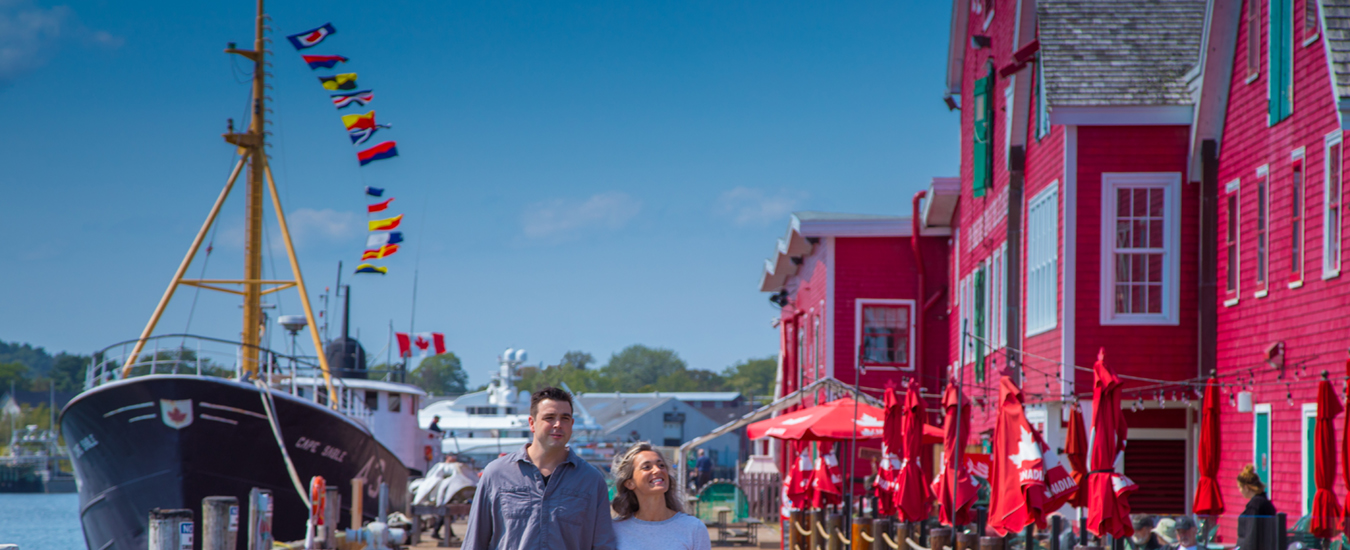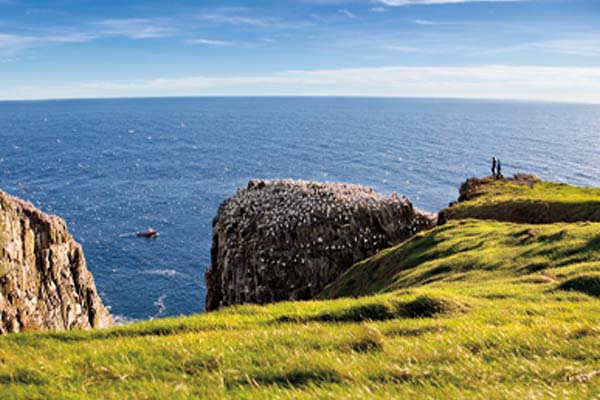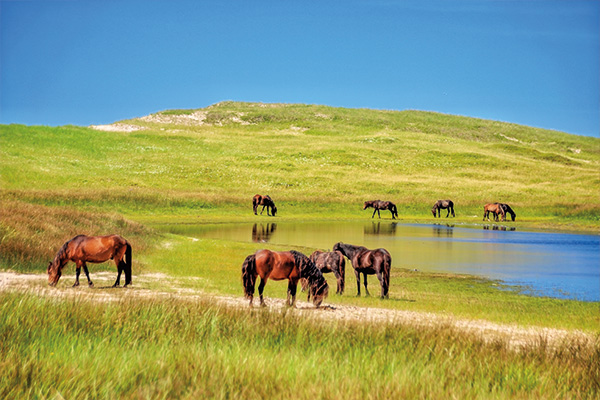Visitors to historic schooner are greeted by the real thing
By Emily Sollows
Where the shimmering blue harbour meets the bright historic town of Lunenburg, you’ll find the Theresa E. Connor, a wooden Grand Banks fishing schooner built in 1938. In the hazy morning sunlight, Theresa’s caretakers, Fred Bennett and Rex Wentzell stroll casually up the waterfront from the stately red Fisheries Museum of the Atlantic.
A fixture of the Lunenburg waterfront, and part of the town’s illustrious skyline, Theresa fished the grueling Grand Banks, off the southeast coast of Newfoundland, until 1966.
Theresa is one of the last surviving Banks schooners, and represents a pivotal moment in history when sails were being replaced by engines, and fishing schooners were ousted by large steel-hulled side trawlers.
Fred opens one side of the gate on the wharf, Rex the other. They walk with familiarity up the gangway ready to start the day. They are two of the five vessel interpreters who work aboard the museum’s fleet—all of whom are retired fishers.
Fred is a former scallop captain who started fishing in 1961 when he was just 16 years old. “We’re all real fishermen that been there, done that. The tourists says, ‘you fellas is the real deal.’ It means a whole lot to them.”
In the past, the interpreters were fishermen who had crewed aboard the vessels when they were in operation. Unfortunately, the “old boys”, as they are affectionately known on the Lunenburg waterfront, are vanishing from this story.
We board Theresa and approach the wheelhouse toward the stern. Fred opens the painted white door with a shimmy and a delicate punch (he knows exactly what works). He opens a tube of brass polish and starts buffing the brass spokes of the ship’s wheel.
“I came up here to Lunenburg for a summer job and never left,” Fred says, cracking a smile that wrinkles his friendly eyes. He points over to the wooden wheelhouse of the Cape North on the wharf beside him. “That’s the one I started on. Spent a year and a half on ’er. She was an old wooden side-dragger built in ’45.”
His intonations echo both Newfoundland and old Lunenburg accents; his inflections and expressions bring zest to every conversation, and life to every story.
“In January ’63 I jumped to scallopin’. I started at age 16. Most the other boys was 50, 60, 70 years old. I was the kid aboard. The old fellers would give ya a hard time.”
Fred fished as captain of his vessel for 27 years before retiring at age 69. “Oh we fished rough—15, 20, 25-foot seas. In the wintertime we come up against it a lot.” Fred says, deepening his tone. “Worst bloody wind is nor’east. Pardon my language. It just keeps comin’ at ya.” He explains they would often have to pound ice off the rigging and equipment. “Oh!” Fred exclaims so achingly that my heart jumps, “It’s cold but ya gotta do it, else you’re in trouble.”
Four years ago, he saw an advertisement in the paper for the vessel interpreter job at the Fisheries Museum. “I says to the wife, ‘well that wouldn’t be so bad. Get out, talk to people.’ She said, ‘Don’t bother, they’re not gonna take ya!’” Fred says with a musical laugh.
Rex climbs up the companionway from down below where he was setting the table in the crew’s quarters. We walk back out on deck, where the men come to the consensus that it’s not too windy to raise the string of signal flags up the masts. The colourful flags read Welcome Aboard in the International Code of Signals—a language few people understand today.
They haul up the flags and toss insults, jokes and chuckles back and forth the whole time. Fred heads over to the port side of the schooner to the little red dory on display. Dories were launched from the schooner to trawl for fish. Each one held two fishermen, their catch and fishing gear.
“This one had 12 dories, 28 men. They would trawl and haul it back to the mothership. They bring the fish back aboard, split ‘em, salt ‘em. They done everything—the whole process,” Fred explains. “They’d start at 3:30, 4 in the mornin’, stop ‘bout 5 in the afternoon. If they had a good haul they’d go ‘til 10, ‘leven o’clock at night.”
Fred makes the judgement call that the winds are just light enough to raise the small sail on the dory. He carefully unties it and hauls up the white canvas.
Fred’s local charm and colour seep through his every word. His stories are like songs that captivate you from the beginning. His vivid tales and vibrant laughs bring the old wooden schooner to life.
Visiting Theresa and speaking with Fred will take you back 100 years when Lunenburg was a hustling fishing port and lively shipbuilding town. A multitude of schooners were built each year and sent away to fish for cod on the Grand Banks. The harbour was peppered with moored schooners, and the wharves were a forest of masts.
Lunenburg is still a bustling town with an old-fashioned warmth. It’s a town that cares deeply about its heritage and works hard to preserve it. A former blacksmith shop now hosts the renowned Ironworks Distillery; the old fish plant on the waterfront is now home to The Old Fish Factory, a restaurant serving the town’s freshest catch; the architecture remains historic; the waterfront still boasts traditional boats and tall sailing ships; the wharves still bear woodworkers, riggers and shipbuilders. The town’s charismatic art and vibrant culture reflect a sincere pride in their history.
Across the wharf from Theresa, you can find crew of the Bluenose II rigging, maintaining and sailing the 161-foot iconic wooden schooner. You can find boatbuilders planking dories at the Dory Shop; and you can find retired fishermen recalling their days at sea, educating visitors from around the world on the booming fishing and shipbuilding village that was Lunenburg. These retired fishermen are part of what make the Lunenburg waterfront such a special place: it is a working waterfront with a living history.
The Fisheries Museum and their fleet of vessels offer a unique opportunity to experience the history of the Atlantic fishery, and the profound sentiment towards it that is still felt strongly in Lunenburg. The museum is a key experience for learning Lunenburg’s story—from the first Indigenous fishers to the industry today.
As the strong sun sinks behind the grassy hill of the golf course across the harbour, Fred and Rex get ready to put Theresa to bed for another night. “Jeez, there’s people who come here in the mornin’ and don’t leave ‘til we close up! They find out you’re a retired fisherman and start askin’ all about it,” Fred tells me while Rex nods in agreement.
They put all the dishes away at the table below deck and lock up the white doors of the wheelhouse. They carefully take down the sail on the dory and lower the string of signal flags.
Theresa, like many other schooners, could have been scrapped, sold or sunk, but she lives to tell a significant story. Fred says with a rare serious tone, “Like I tell people: if they didn’t look after this ship, that’s a lot of history gone. That woulda been it. It takes a lot to keep her going but I’m glad they did.”
Looking out at the Lunenburg harbour, you can almost see a young Fred and his crewmates heading out to sea on wooden ships. In this timeless town, you can’t help but imagine what life would have been like century ago.
Header credit: Tourism Nova Scotia / Acorn Art Photography
Header caption: Walking the old boardwalk in front of The Old Fish Factory;
Intro credit: Tourism Nova Scotia / James Ingram
Intro caption: Sampling the wares at Ironworks Distillery



